Updated:
On our recent visit to Johannesburg, I had some reservation about seeing the Apartheid Museum. I knew it would be hard, emotional and might make me angry. We were enjoying the city as a whole and thought this might just drag us down enough to reverse our original feelings. I finally decided that we should go for it, so on our second day of the Hop-on – Hop off ride, we got off at the famous #5 stop which was the museum. This is how it felt to be confronted by a dark past in South Africa’s history.
Apartheid Museum Johannesburg Visit:
[the_ad id=”13767″]
Apartheid Museum Entry fee:
The front of the museum is a quite ordinary. Very brown and lackluster. You pay your apartheid museum entrance fee of roughly $5 converted from South African currency (Rand). Behind you is a huge image of Nelson Mandela, the Madiba as he is known. We paused to take a picture by him. Next, you enter through this walkway, which is where it starts to get real. There are two entrances, one for Whites and one for Others (everybody but whites). You are randomly given a ticket designating what entrance to go through, just like quite a few people where doing during the days of apartheid.
Apartheid Meaning:
Chinese people were classified as Black sometimes, some Negroes were classified as Asian etc..etc. They didn’t even bother to ask as they were not regarded as people. Because South Africa was rich in gold, people came from all over in search of fortune through gold mining. As you can imagine, various cultures living together made for a very diverse population and of course racial mixing, which was not to the liking of the government. During the apartheid period, segregation was designed to prevent this racial mixing.
After this room, we went out to the courtyard and there are full size cutouts of children and grandchildren of men and women who had emigrated to South Africa during the gold rush. These cutouts were posted on mirrors and formed a path along the walkway. To the left of these was a long wall filled with little stones, going up as high as 10 feet or so. I thought it was just for decoration until l heard a private guide telling the 6 tourists he had that each stone represented a life lost under apartheid. That was extremely sobering because there were lots and lots and lots of stones. Lots! 🙁
[the_ad id=”13784″]
Apartheid Museum Interior: Emotional Powerhouse
From there you go inside of the museum. We have no pictures because photography is absolutely forbidden inside. There are amazing magnified black and white images all over the place. I wondered how they had managed to get those. A lot were taken by a man by the name of Ernest Cole, a self taught photographer who was given a Nikon F film camera by a priest. Wanting to leave South Africa, he was later reclassified as “coloured” allowing him to travel. He snuck his prints out and they were later published with Random House. The book, “House of Bondage” was banned in South Africa of course.
All over the museum, there are tons of stories from the days. Some stayed with me and struck a nerve or two. One story had a young black man, about 13, who had forgotten his papers at home. Upon being caught in the city, he was sentenced to some farm, hard labor, never to be seen again by his family. The farmer killed him just because and buried him in some corner of the farm, but not before being seen by another black kid who worked there and managed to escape. He told the family what had happened to their son. They pestered the police until finally they were able to have the body dug up and brought home. Nothing was done to the farmer because black life really didn’t matter (sound familiar?).
A few photographs showed black women carrying white babies on their backs and treating them like their own. They were good enough to take care of their kids, cook their food, rape and kill, but not their equal. Most took their maids with them on vacation and they considered that as treating them well. In the pictures, you can see the maids carrying the umbrellas etc as the bloated masters walked on the beach or the housewives lying poolside while the maids were rushing about them. Would l have poisoned a bunch of people had l lived then? You betcha! and it would be slow poison too ;-).
There were so many stories and startling images. A lot of the black women had no education and therefore were often jobless. They discovered how to home brew beer and sold it to make ends meet. The government made new laws disallowing this because it was taking money away from the beer salons. They would often beat and raid these houses. From the photos, it seemed the most beer they could make at a time was a glass or two from these teapot looking things, but anything to make life impossible for them. It was heartening to see at some point, over 2 million women l think it was (Black,White,Indian..everybody) marching to the government house and delivering petitions to make sure that these women could continue their home brewing.
Related Reading: Auschwitz Concentration Camp
Protect your trip. For your free travel insurance quote, Click Here
On one whole wall, there were the laws made during apartheid. They were actually kind of amusing to read. I counted at least 152 laws and modifications. The activists were thorns in the side of the government. As soon as a new law was passed, they would make sure to break it and so a new law or amendment would be added and they would break that too just to make things difficult. It was an ever changing landscape of rules designed to wear the government out.
Apartheid Timeline in South Africa is presented in this fascinating museum with recalled details, newspaper documentation, apartheid resistance fighters etc. There were also videos and photographs from protests by the African National Congress (ANC) whose original mission was to end apartheid through non-violent means. This changed when 69 Blacks were killed during what is known as the Sharpeville Massacre.
The party was then banned and forced to leave South Africa. Later on, in 1990, then President F.W de Klerk lifted the ban on the ANC and freed Nelson Mandela who had been imprisoned for 27 years. Growing international pressure and fear of civil war were the main reasons for freeing him. It was really interesting to me to read about his life and see how much he had to endure under apartheid. Find hotels in Johannesburg.
[the_ad id=”13783″]
Pin for later:
My takeaway from the museum was that often you hear so many stories of the despots that come to power. People like Hitler who hog all the news. Amid all that, it’s nice to hear of people like Mandela and Ghandi who also accomplished a lot by doing good. It’s ironic that a man, whose birth name is Rolihlahla, which essentially means “troublemaker” turns out to be one of the greatest peace makers of all time.
If this man, Nelson Mandela, who was locked up for quite a few years in a tiny cell could forgive, move past it and strive to make a great nation, then what the f**k is my problem as an outsider? I actually feel like the South Africans themselves have taken his word to heart and what l observed in the city is racial harmony that is severely lacking in the U.S for instance, especially now. We could definitely learn a lot. Here are some of my favorite quotes by Mandela.
As I walked out the door toward the gate that would lead to my freedom, I knew if I didn’t leave my bitterness and hatred behind, I’d still be in prison.”
“No one is born hating another person because of the color of his skin, or his background, or his religion. People must learn to hate, and if they can learn to hate, they can be taught to love, for love comes more naturally to the human heart than its opposite.”
“Resentment is like drinking poison and then hoping it will kill your enemies.”
― Nelson Mandela
Related Reading: House of Terror
In this day and age where we seem to be regressing as humans (evident in conflicts and a return to hate crimes in so many parts of the world), it seems that we still have a lot to learn. The evil that is inside men seem to be flourishing under the current leadership of countries such as the United States, Italy, Hungary just to name a few. I hope people remember that this is how it all started before WWII when the little man with the moustache started his reign of terror. It’s easy enough to think things won’t affect you, at least until it does, and then it’s too late.
Do what you need to to make your voice heard. Your most powerful weapon is to research your leaders and vote for the person who has the best interest of everyone into office. By everyone, I mean every one! Don’t hide behind religion or what have you to try and separate yourself from others. Your job is to love and lead a good life, leave the judgement to the high being.
Have you been to South Africa? If yes, did you go to the museum and how did it make you feel? If not, would you consider going, or would it be too emotional?
[the_ad id=”13768″]

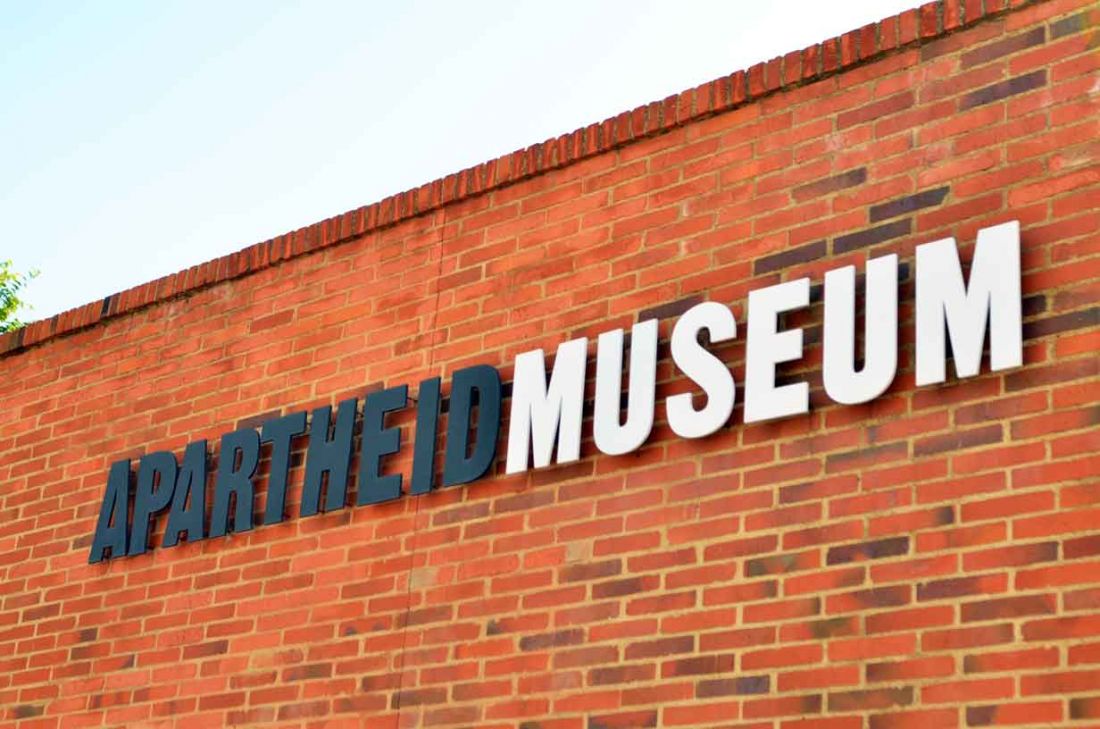
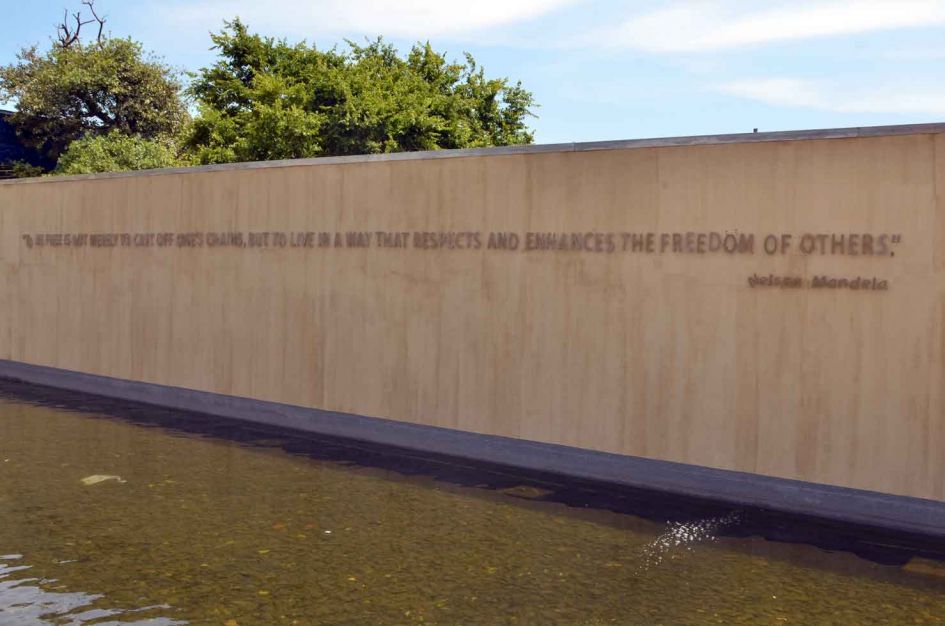
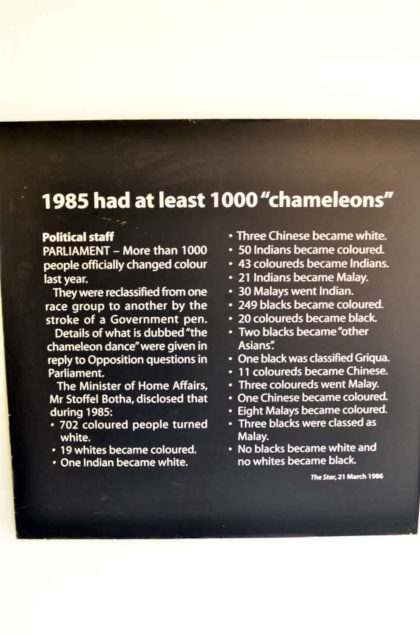
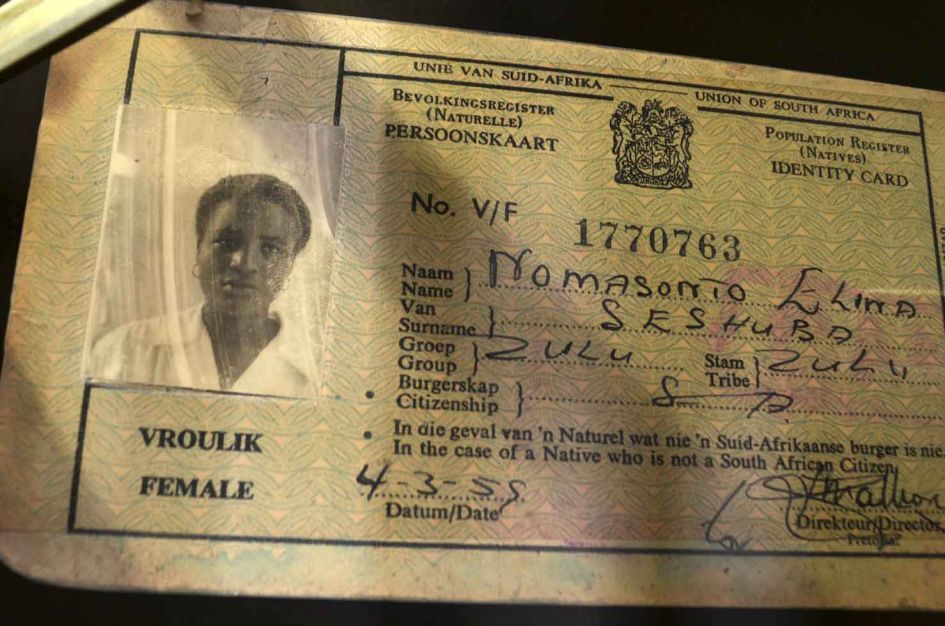

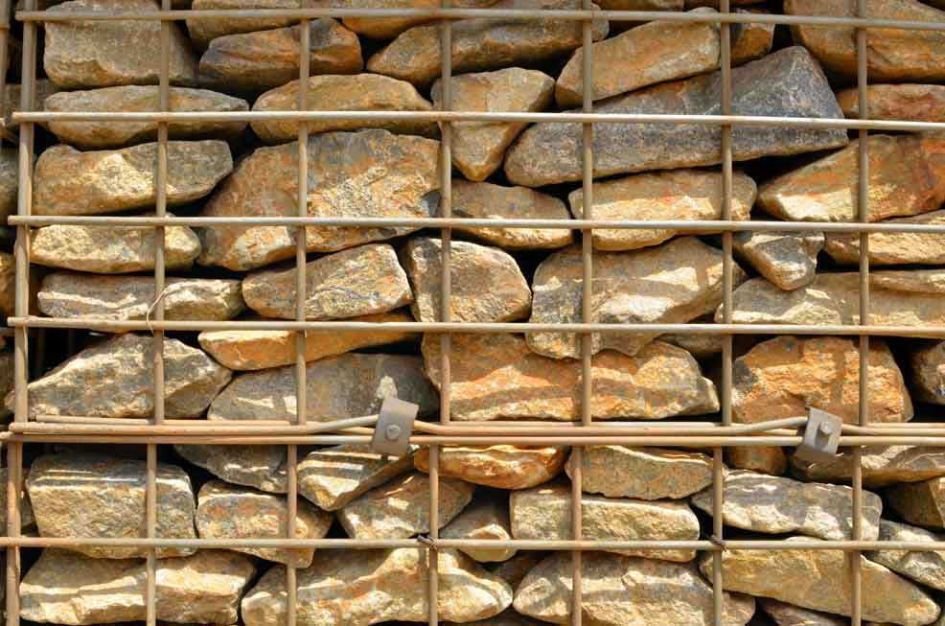

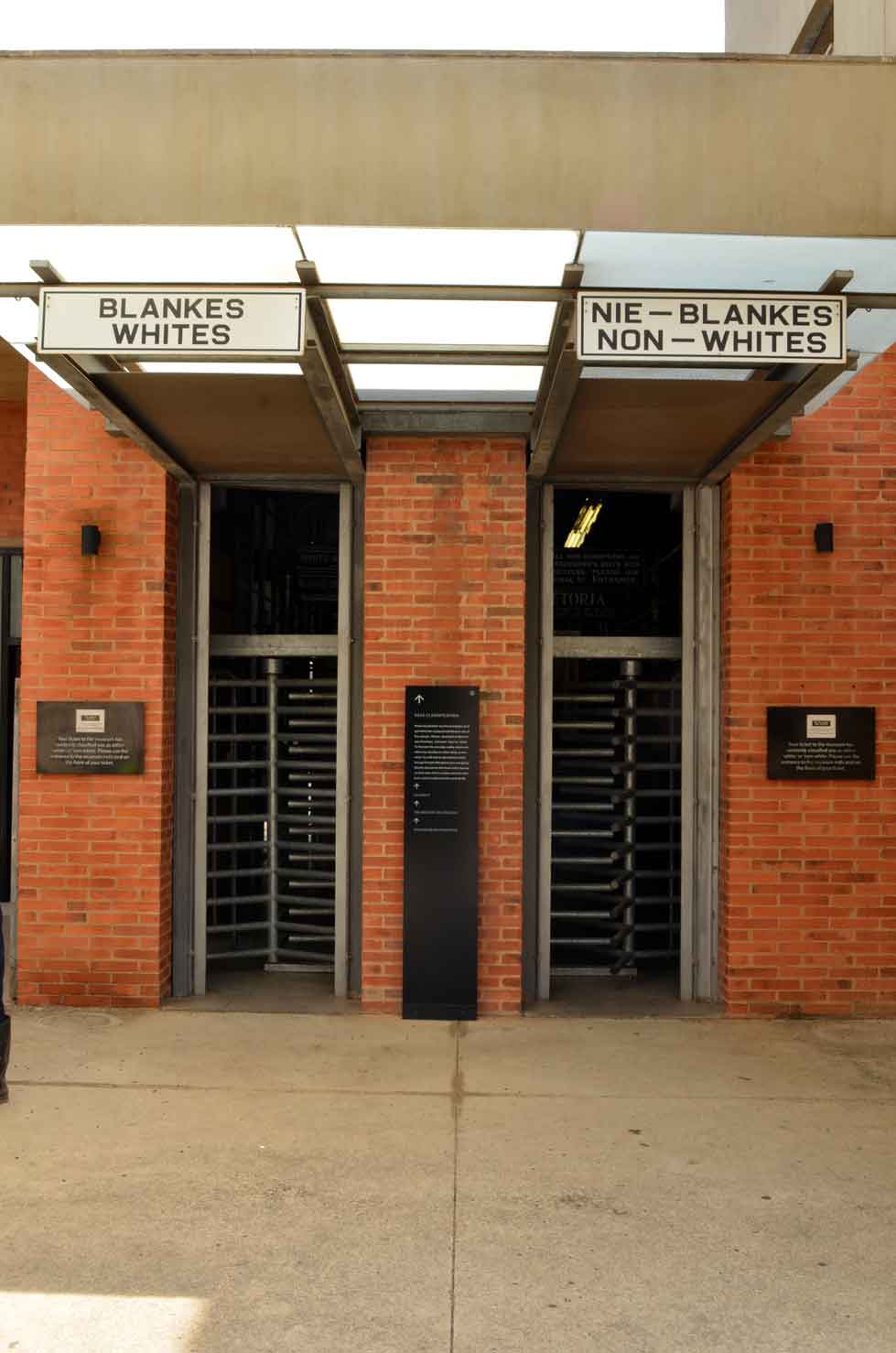
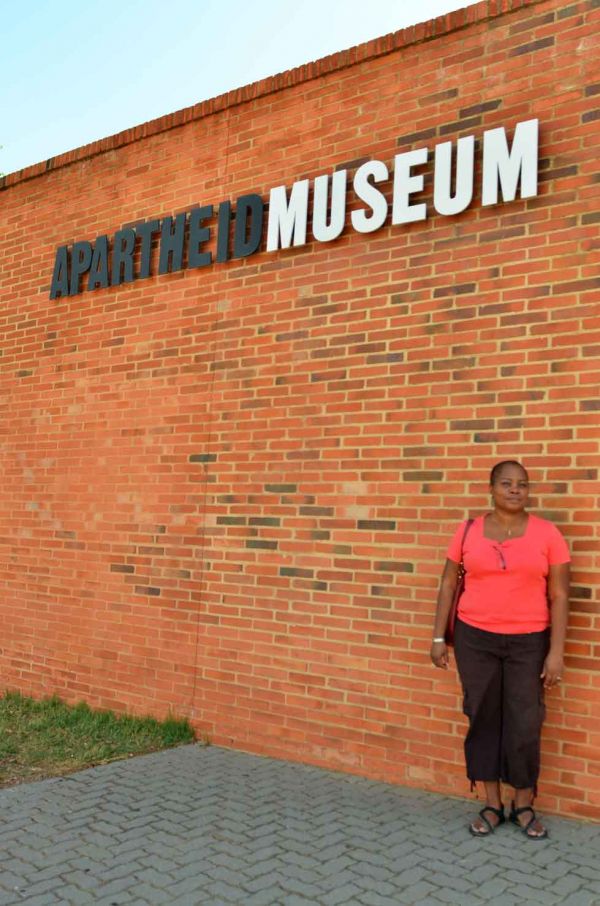

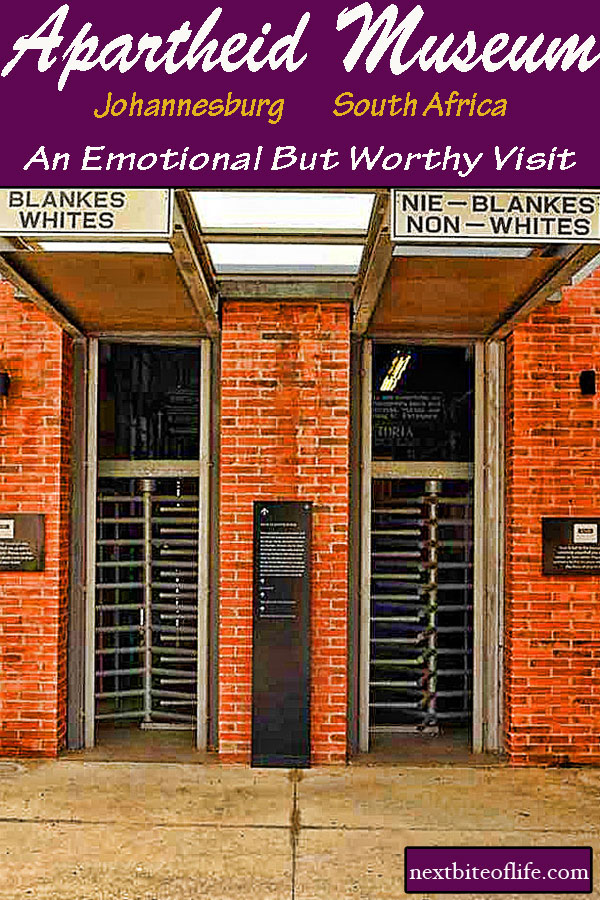



Nice post. We visited Robben Island earlier this year, was interesting to see the Island where Mandela and other political prisoners were kept. We also left with a heavy heart. Interestingly enough, a political prisoner there along with Mandela was Jacob Zuma, South Africa’s current president. Right now I think a lot of South Africans would love to send him right back to Robben Island.
Frank (bbqboy)
Thanks Frank. I find it fascinating that we never learn anything from the past despite all the history classes. It just keeps repeating itself. On the next trip there, l hope we get to visit the island. They had the life-size dimensions of the cells and they were tiny indeed. I have to read up on him.
Very moving KemKem – Lamia
Thanks Lamia. It was 🙁
Very real, strugglesome piece. I would be emotionally challenged by this museum. I lived in the Southern USA in a small Southern town for five years of my adult life. That was hard for me. I grew up on a tiny Midwestern family farm. The values I learned growing up in this small, rural community is work your ass off and you can get what you want. And so I did. Moving to that Southern town quickly taught me that even I (WASP) was required to state my name, my address, and my husband’s job in order to look at refrigerators at the appliance store. Eyes opened, Little Terri. ——- Well, sorry for the rant. I will try to live and honor each day and each personal interaction as the people who fought for equality, peace before me in all places would be proud of. Thanks for the post.—–Terri
Amazing how prejudice manages to show its ugly face for everyone. I’m sure it must have been emotionally trying for you those years and quite shocking. I think at some point, you just don’t acknowledge it all the time and you become emotionally spent. It’s probably the only way people can handle things without going crazy. I just hope we human beings wake up and realize that we are all one if we ever want to make a better place for the future generations. Sadly l think it’s a lesson we shall never learn, which l find sad. Rant on missy! 🙂
I have so many stories from that Southern small town. I should write them down. I’m forgetting them, and they’re so revealing. Yes, I agree with you. At some point, I think people in that small town stopped acknowledging—I couldn’t.
BUT, thanks for the post on the museum. The seed for South Africa has been planted for travel in my mind. We’ll see how it grows.
You definitely should write them down. No matter the amount of brain food, memories start to fade.. LOL! I hope the seed grows, it’s an incredible place from what little l’ve seen and l definitely want to see more.
You made me laugh! Brain food.
🙂
Wow, that’s really intense and sad. Proves, though, that we’ve managed to evolve and get far… hopefully the recent wave of hate that seems to be taking over the world in recent times is nothing but a bubble that will auto-destroy itself.
I too hope that the recent rash of horridness will go away just as quickly as it appeared. I fear it will only get worse before it gets better though. Yeah, it was emotionally draining but l admire the people of S.A for the way they chose to handle it full on. Reminds me of Berlin a lot as far as that is concerned.
Wow, very powerful K, and a timely post as well since nativism, rascism, xenophobia and prejudice in all its guises against “the other” is alive and thriving. How heartbreaking to read of 150 laws and umpteen more versions of life under apartheid and think about spending one’s life walking the tightrope. So many lives lost and so much talent wasted… What is really astonishing is realizing that, just like the civil rights era of the US and equal rights movement for women in the 70’s, apartheid is such recent history. And, after last week’s election that left us shocked and stunned, it looks like the US and the world are moving to the right and backwards several steps… I am sad and I am angry! Anita
Yes, it is kind of sad that for the wonderful steps we have taken forward, we seem to have taken quite a few steps back. I don’t blame you for being mad and sad :-(. It’s unbelievable how much hatred and venom there seems to be in the world right now. Warning people to get out of Aleppo before the bombing when the place is one giant rubble already..it goes on and on. I am kind of losing faith in human beings. Yeah, the tightrope mush have been crushing for people. I am so glad l was spared that. I wish l had the answers to fix things 😉
Thank you for sharing your experience visiting the Apartheid Museum. It is very emotional and powerful. It would be nice to read about a museum such as this and think that we are so far removed from this kind of thinking, but with recent events we are reminded that there is still a long way to go. If more people could see themselves (humanity) in others and leave bitterness behind we would be in a better place. I’m glad that you observed positive racial interaction during your trip. It gives me hope.
Thanks for reading Kizzy. If there is one thing that you indeed take away from the experience, it’s hope. Seeing how people have somehow managed to get past this horror for the most part and moved on really does make you hope that we can do better. Always. I like what you say about people seeing themselves in others. I really do think it would make a difference. It all feels like a bad dream from which l can’t wait to wake up from :-(.
My brother in law went and he told us about the experience and he said he kind of felt some of the agony and pain while visiting. I can’t imagine what people had to go through and although I love the stories and the history…I can’t help but get mad and sad at the same time!
It’s perfectly okay to feel both, and even more. Sometimes, l felt murderous. My husband was loudly going around saying “piece of shit” at every picture with the smiling faces of the oppressors :-). You can’t help but feel something, but that is also what heals l think. Acknowledgement of a brutal past. I am just glad that people like Mandela got to see the end of what they started, and chose to heal. Commendable 🙂
This is such a touching post! I felt like I traveled through the museum with you. I have never been to South Africa and may have not wanted to go to the Apartheid museum because of all the emotions. it would bring up. However after reading this, I don’t know I how I could not go. Thank you for this!
Oh wow! Thank you so much for such a wonderful comment. I’m so glad you get it. It would be a disservice to oneself to go and not experience it. Your emotions run wild for sure at the outrage, but the triumph of perseverance wins out overall. You really understand how and why Mandela was able to bring everyone together. He was really key in the healing and forgiveness and l am so glad he lived to see his vision realized for the most part.
Great and informative post. I pinned it and will be sharing with my family later. This one of those things when you have to get your mind together to read and taken in. Thanks for sharing
Thanks a lot Trenara. I appreciate it. Yeah..you have to have the right mindset to take it all in. Thanks for reading.
Wow, that would have been emotional for me to see! I have never been to South Africa and honestly didn’t know they had a museum like this. It’s sad to see what they went through.
It is definitely sad to see what horrible things happened, and so recently in history. The good thing is that everyone encouraged us to go visit, Blacks and White that we met, so they really confronted it head on which is a good thing.
I really shouldn’t be surprised, but it never dawned on me that there was such a museum! Thanks for sharing this vital data with us.
I didn’t know either until we got there. Most places would sweep it under the rug l think 😉 . Thanks for reading.
This sounds so familiar to the US…this is a sobering read. I really wish I could go to sleep and wake up and racism wasn’t a thing. But…that’s just wishful thinking. Thanks for sharing your experience with us. If I ever make it to South Africa, I want to visit this museum.
It really is scarily similar isn’t it? We take one step forward and seem to take 7 steps back. Very sad! Yeah..it seems like a nightmare that we all seem to share. I certainly hope history does not repeat itself. Anywhere! I hope you get a chance to visit this museum at some point. Worth it.
You did an excellent job recapping your trip. MY gosh at the white & non whites entrance. Like WOW! I’m like you girl, I would put some “Suge Avery pee” in their water.
Haha! I kept thinking that as l read the stories. Like they would find me out eventually, but l would have killed a few by then ;-). Thanks for the compliment . The images were huge poster sizes and there was one of a white lady coming out of the public white toilet clutching her purse fearfully, even with a police woman at her side! Insane. So glad that man was able to escape with the prints, otherwise there wouldn’t be evidence per say.
This was a great recap. I really need to visit. I loved all of the photos. I’ve heard that certain parts of SA are still racially divided…
Yeah. I assumed the same, but Johannesburg at least seems to be a progressive city. My friend and her husband spent 3 months in Cape Town and even though she loved the food and wine culture, she did not like the city as it was still racially divided, and being a Latina was treated differently till she spoke. I will stick with Johannesburg l think 🙂 . Lots of affluence there for every color and sex .
Yeah, no, I’m not ready. I couldn’t get through all of this just yet. I’m still too raw from the elections and the fallout in my community. I really would love to go to Johannesburg though.
No worries. There has been too many punches coming in lately so it’s understandable. Johannesburg is really nice and l can’t wait to visit it again. I’m pretty sure now l would prefer it to Cape Town. Keep your spirits up and hope for the best with the world. 🙂
WOW! I can feel your emotions. I still can’t wrap my brain around such things like apartheid.
I know. Pretty insane right? This world is pretty screwed up, even right now 🙁
I would love to travel to South African and its definitely on my bucket list for when the kids get a little older. I can’t imagine entering the museum through different doors as I assume you and your husband/partner did. Powerful.
Yeah..it kind of sobers you up pretty quickly. It was very upsetting and emotional for him as well and he cursed a lot during the visit 😉 . You should definitely visit. It is worth being on the bucket list. I haven’t visited any other parts except for Durban for 24 hours, but l liked that too.
The way I feel right now, I don’t think I could visit that museum. God knows we as a people have been through so much.
I feel you. It’s like the more things change, the more they stay the same. It’s insane that after all that, we just seem to be regressing 🙁 .
This must have been a hard experience for you, but I am glad you did it. The image of the stones symbolizing lives lost was so tough to stomach. Hopefully, the darkest days in the history of that country is forever behind them.
I certainly hope you’re right. That the dark days are behind them forever. It was very sobering to hear the guide say that. I imagine that are just people that they identified. Imagine all the ones that just disappeared and were never found. I’m glad we did it too. Mandela was an awesome man. I don’t know many people who would be forgiving.
I have to recover from the African American History museum before i can see any more suffering for black people. I am still not over it. This seems like a very emotional experience.
It sure is. I can understand that. There is so much suffering everywhere. We need to sometimes take a break from all the suffering and smiling history and just chill. Nothing wrong with that 😉
Visiting a place that highlights how one group of people have overcome oppression really shows how resilient humans are in our world. The story maybe said but the triumphant tell is so much sweeter. What an amazing experience.
Very well put. Human beings really are resilient and for many to live to see their triumph makes it even better. It was a really emotional visit but l’m glad we did it.
I’m sure this visit to the museum was emotional. I have never been to South Africa. I’m not sure I would be able to go to the Apartheid Museum. It would be too emotional for me.
The U.S has a pretty emotional museum or two as well. I wouldn’t blame you for skipping it. We actually liked it because it gave us insight to what had actually happened. The news feeds us crap and that is what we knew. To see the real accounts was both horrifying. The ultimate triumph and the end of apartheid makes it satisfying.
I have been to South Africa (back in 2004), but I didn’t particularly like it or not like it! I did however, like the people. They had no resentment in their hearts and were doing their best to bring peace back to their country.
I visited Robben Island and it was sombre moment staring at where Nelson Mandela lived for a huge chunk of his life. I love history, but I admit that I feel uncomfortable and upset when that particular time in history is too close in time or I see a real item belonging to a real people who lived and breathed, rather than a fake one!
Having said that, showing these attrocities as they are, is the only way to bring it home to people, that it’s not a Hollywood film, but real-life!
Boom! Well said. The pain being raw made it real, and bring it home to people like you say. Real life smacking you right in the face. Yeah, sometimes, it was too real but l do appreciate the fact that the confronted their dark history head on. Kind of how l felt when we visited the Berlin Wall. Nothing swept under the rug. Everybody striving for better days. I hope to visit Robben Island one day. That I’m sure will be super emotional.
Visited the museum 2 days ago and spent about 3 1/2 hours there. We also hired a guide to visit Soweto for a 1/2 day. The museum is very powerful and filled with pictures and information about South African history and specifically apartheid. There is also the special Mandela exhibition. I don’t know how you felt about the museum layout but we had trouble following all the events and understanding the interactions within all the different white groups and within all the different black groups. It was almost too much information to process the way it was layed out. Besides our overall feelings of how terrible apartheid was, we also saw how very complicated it was for the blacks to fight it – how many different black groups rose to power and then lost support – and even right after apartheid was eliminated how fighting for power still continued. Seeing all that, it was even more impressive how Mandela could bring the country together.
Soweto is virtually 100% black even though we saw beautiful areas with gorgeous homes. Whites still won’t live there. The present government is corrupt but people we talked to didn’t agree on which party would be better. We were told unemployment is 25-35% depending on the area and people seemed hopeful but realistic. We found the people we met in Soweto to be incredibly friendly. We visited one of the poorest areas in Soweto which was like those we’ve seen in other developing countries but it felt worse because of the much nicer areas surrounding it.
I enjoy your posts. Thank you for taking the time to write.
Steve
Hi Steve. I do agree with you about the layout of the museum. It was a bit confusing. It probably would have been better if the Nelson Mandela side was inside of the main building. We kept running in and out of stories, but l didn’t mind it too much. We did visit Soweto and it was definitely jarring to see all the tin shacks and then see nice little houses surrounding it. I don’t think l could live so close to so much squalor and not have it affect me. Oddly, Soweto didn’t pull me in as much as l thought emotionally. There are so many places like that in Nigeria that it was just “another one” and a sigh..which sucks because one shouldn’t be so apathetic. I remember watching The Constant Gardener in the movies and l remember crying for a long time like everyone else. Soweto will remain Black l think. It’s hard to think of anyone wanting to move voluntarily to that area, cute houses or not. I wouldn’t. The government corruption is like everywhere in the world, seems to be a very common disease doesn’t it? I know for sure my heart isn’t forgiving like Mandela 😉 . It is absolutely amazing what he was able to accomplish. I wish there were more like him in power, everywhere, instead of selfish bastards who think only of themselves and their immediate families :-(. I’m so glad that you were able to visit and add your voice to the discussion. Very much appreciated. I would love to visit the country for longer as we really enjoyed it. Hope you did too.
I’d love to visit this museum whenever we finally make it to SA. It’s incredible what South African POC have overcome, and I think it’s even more incredible that there’s such racial harmony there in Jo-burg now.
I, like you, would’ve been poisoning folks left and right. Grinding up glass and sprinkling it in their food, arsenic, rat poo, you name it – it would’ve gone into their food. And into their kids’ food. I’ve always said that I’d do the same back during slavery. Thank GOD I was born in 1980 because I seriously think I would’ve been killed/lynched if I’d been born 50-100 years earlier.
The U.S. has a long way to go in terms of racial healing, and I think it’s primarily because many white Americans don’t acknowledge their sh*t or speak up in the face of injustices against POC. So Jo-burg gives me hope, and I’m looking forward to visiting one of these days.
I hope you do get to visit whenever you make it to S.A. It will definitely have your emotions in a roller coaster mode 🙂 . Yeah, it’s a testament that there is harmony there. I can’t speak for other areas as l haven’t experienced them yet, but certainly hope to. I know, it was hard not to have murder on my mind as l read all the stories. I think maybe the souls were so crushed that they couldn’t think past survival. It’s easy to be looking in from afar but yeah, l think l would never have made it. I would have been killed pretty quickly ;-). Yes, the U.S has a long way to go. We seem to be taking steps backwards which l find really, really sad. It’s not going to change till everyone, Black, White, and every shade in between works as one to get rid of the infestation. Jo’burg gives me hope :-).
I can’t even imagine the emotions during this visit. This is definitely a place I would love to see with my own eyes.
It is definitely worthy of a visit, and yes..your emotions run high. It’s just amazing how cruel human beings can be, but it does give you hope because of the few good ones :-).